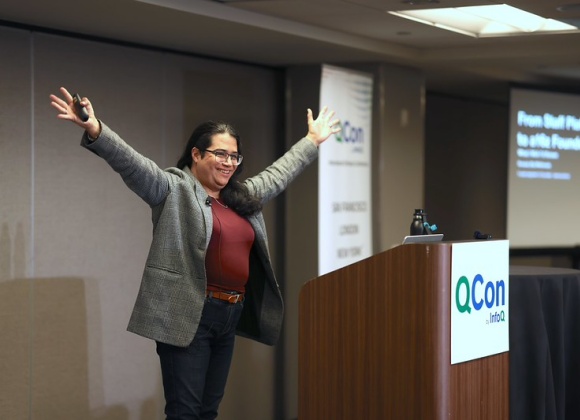This is the Engineering Culture Podcast, from the people behind InfoQ.com and the QCon conferences.
In this podcast recorded at the Agile 2016 conference, Shane Hastie, InfoQ Lead Editor for Culture & Methods, talks to five of the leading minds of Agile Management: Steve Denning, Ray Arell, Todd Little, Hendrik Esser and Steve Holyer.
They explore the question “Is agile still agile?”, look at the challenges around agile development and product management, and what is needed for large scale agile transformation.
Key Takeaways
- Agile is a mindset, not a set of processes or practices
- The risks and dangers of packaged implementation of “agile” using process checkboxes without understanding why
- Agile adoption is hard – simple but not easy
- When agile practices are adopted for the wrong reasons it causes stress levels to go up and drives unsustainable behaviours
- It’s not “twice the work in half the time”; it should be about twice the value with half the work
- The Scrum role of Product Owner is broken
- Product management is the hardest part of product development, irrespective of the development approach
- In a complex world your only chance for survival is learning
Subscribe on:
0m:40s - Introductions
1m:44s - Responding to the question “Is Agile still agile?”
1m:55s - Agile is about mindset, but it is being corrupted by approaches which put more emphasis on tools and processes.
2m:10s - The main focus of the Agile Manifesto is about the mindset.
2m:30s - The Agile Alliance mission is about making software solutions more effective, humane and sustainable.
2m:40s - Many organisations are adopting agile practices which encourage productivity without being humane nor sustainable.
3m:15s - In large agile adoptions, very few teams and individuals are able to relate their way of working to the values and principles in the manifesto.
4m:15s - Some teams can benefit from checkbox, packaged implementations of agility as a starting point but they must be able to evolve.
4m:30s - Agility is a journey – you need to be agile in mindset, based around continuous improvement.
4m:40s - The most agile teams are the ones who continually inspect and adapt their practices to work most effectively for their context.
5m:00s - Checkbox teams who follow every one of the practices without knowing why are unable to improve and are not effective.
5m:15s - It’s about understanding and getting to the heart of why – for your process and for your product.
5m:30s - The checkbox process is easy for companies to measure and doing so drives bad behaviour.
5m:50s - Organisations create checkboxes so “managers can get the bonus”, not so the teams can be effective.
6m:15s - Agile is hard. t’s simple but not easy.
6m:40s - When agile goes wrong the stress levels in organisations go up, because these practices can be misused to cause harm.
6m:54s - Example – in waterfall projects there is low stress at the beginning, then it climbs higher as the deadline approaches, plateaus as the deadline is missed, and drops after the product delivered.
7m:10s - Scrum can be used to have a steady, sustainable pace, or it can be abused to demand that teams “sprint” all the time running at a constant high level of stress
7m:50s - The misuse of the daily standup where everyone reports status to a “master”.
8m:05s - Agile should be a customer/user focused way of working.
8m:30s - The real bottom line for value is, are you delivering products that customers want and will be delighted in?
8m:40s - It’s not “twice the work in half the time”- it should be about twice the value with half the work.
9m:05s - The promise of leadership from consultants is about productivity going up; it should be about value for the customers and for the organisation.
9m:30s - Companies struggle with strategy and product management. Real productivity comes when strategy is clear and product management is aligned with the strategy to ensure that the right products are built.
10m:05s - One of the issues with Scrum is the magical beat called the Product Owner, who knows everything about every aspect of the product and who is able to prioritise the complete backlog – this simply doesn’t work in any reasonably complex environment.
10m:15s - Product management is the hardest part of agile or non-agile product development.
10m:55s - The way we measure activities in organisations mitigates against outcome-based approaches and drives the wrong behaviours.
11m:55s - We’ve been looking for “efficiency” measures, but the reality is we should be looking for outcomes and effectiveness measures.
12m:25s - The agile consulting community has fallen into the trap of “speak their language” and selling agile adoption based on efficiency, not effectiveness.
12m:55s - In the super-complex digital-focused world, executives do understand the need to take a different approach, we need to meet them on this journey.
13m:25s - The layer of middle-management is the area with most resistance to change, because they feel the weight of change and are often misaligned with the drivers from above and the pressure from below.
14m:05s - Often, the directions from above are misinterpreted and misrepresented through the middle layers to sustain the status quo.
14m:55s - There is a disconnect between the agile ideas around delivering value to customers and executives being measured by stock price and shareholder returns. These two goals are fundamentally opposed and we need to reconcile this dichotomy before we will have successful agile transformation.
15m:32s - The companies who are successful in their transformation are the ones who have realised and addressed this disconnect – by delivering value to the customer we generate more shareholder value.
16m:10s - What does it mean to have an agile mindset?
16m:20s - The mindset manifests in day-to-day behavours.
16m:35s - Examples of the mindset in action.
17m:10s - People are clever and are able to adopt changes when they understand the drivers and why they matter.
17m:23s - Example of estimates in ranges and narrowing the range of the estimate with every sprint as more is learned; able to respond to changing circumstances and convey the evolving truth to stakeholders.
18m:35s - Examples of small glimmers of hope in teams.
19m:20s - An important question to expose the agile mindset is, do the teams value the agile values? Easy to see but hard to measure.
19m:50s - We are in a world where the reality is that we are managing under uncertainty today. The illusion of certainty is a falsehood.
20m:20s - There is rich science around managing in uncertainty in some business domains (eg oil & gas).
20m:25s - In software we still try to pretend that we are managing in certainty, which leads to many of the issues we face. We are in constant denial.
20m:48s - There is no silver bullet.
21m:03s - Everything we do is research – every product is unique; we never build exactly the same product twice.
21m:22s - There are five dimensions of the agile mindset:
- A goal about creating value for the customer
- The management approach needs to enable others, not tell them what to do
- Accept uncertainty and proceed in an iterative fashion towards the solution
- Values of transparency and continuous improvement
- The importance of communications and conversations
22m:30s - In Ericsson, one of the areas of focus is the quality of interaction; possibly define maturity levels related to communication effectiveness.
23m:25s - These mindset elements are hard to measure but easy to observe. The Learning Consortium is a group of organisations who are sharing knowledge in these areas, and the presence of the mindset factors is “instantly visible” when visiting organisations that have it.
23m:55s - It is possible to measure, and to systemise the elements of the mindset.
24m:30s - Middle management are the guardians of the old order – it is important to bring this group along with them.
25m:10s - “I’ve been scrummed before” – bad experiences from process driven implementations.
25m:30s - Agile has been around long enough that we have evidence of what good implementations look like, and lots of examples of bad implementations that have caused harm.
25m:50s - Top-down support coupled with bottom-up drive results in better outcomes. Barclays as an example.
27m:00s - Counter example of the initial response within Intel when adopting agile was mooted, and resulted in a covert adoption hidden from the organisational hierarchy.
28m:25s - Embodying the agile manifesto values and principles results in “a good company to work for”.
28m:31s - Hiding or shielding agile adoption is not sustainable – it needs leadership support.
29m:00s - The polarized nature of the working environments today: management is bad vs teams are lazy.
29m:30s - We have Scrum and other agile processes for technical team implementations – we don’t yet have the management practices and processes well-defined for other areas of the business.
31m:17s - There are some hard constraints which need to be taken into account.
31m:38s - The majority of management teaching pushes people towards a linear, fixed mindset; need to help them unlearn and relearn.
32m:25s - Some hard questions that need to be addressed every day at the coalface of doing business.
32m:40s - Example of a Nova program about delivering the Mars Rover, and how taking a modular approach to the work allowed them to meet a hard, fixed deadline while dealing with uncertainty.
33m:50s - When you ask a customer “what will you need five years from now?”, people make stuff up because they don’t know.
34m:55s - Agility is about adjusting to the context that you have.
35m:55s - The importance of feedback loops and iterating for exploratory learning.
36m:18s - Lean Product Management – designing experiments intentionally to learn with and from your customer about what their real needs are.
37m:42s - How Spotify is an example of evolving processes based on continuous learning, and continually learning; autonomy and alignment together.
38m:45s - Successful firms are not mandating the teams’ processes – they give them the freedom to work out what works best in their own context.
39m:00s - When there are lots of dependencies between the teams they need to coordinate and converge more, so some of the autonomy is sacrificed for alignment, examples of Riot Games and Spotify.
39m:55s - Can we learn from DevOps and agile, and apply this thinking to organisational design? Break things into smaller chunks. Maybe we should come up with different ways of structuring the organisation.
40m:35s - Structure needs to be fit for the context, and as products grow and have integration points then the structure needs to adapt for the new context. For example, consistent testing frameworks.
41m:40s - The value proposition for many acquisitions is integrating the different products. You need to first integrate the people and then there needs to be alignment in the way people work, reducing some of the autonomy. The hard question is, how much is enough for the balance between alignment and autonomy?
43m:00s - Don’t try to manage everything – manage the interface. Take a systems-thinking perspective approach to organisational design, rather than the normal “ego based” design based on control.
43m:50s - Structure is neutral. What brings structure alive is the people, and the mindset of the people in the structure.
44m:30s - The visible evidence of organisation mindset – where the executive office is.
45m:00s - The key to the mindset is the ability and willingness to learn.
45m:48s - In a complex world, your only chance for survival is learning.
Mentioned
- nuCognitive
- Forbes
- Accelinnova
- Ericsson
- The Agile Alliances
- The Learning Consortium
- Barclays
- Nova – Ultimate Mars Challenge
- Lean Product Management
- Spotify
- Riot Games



